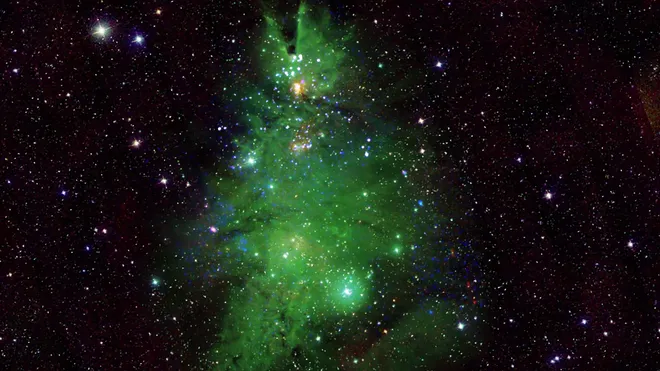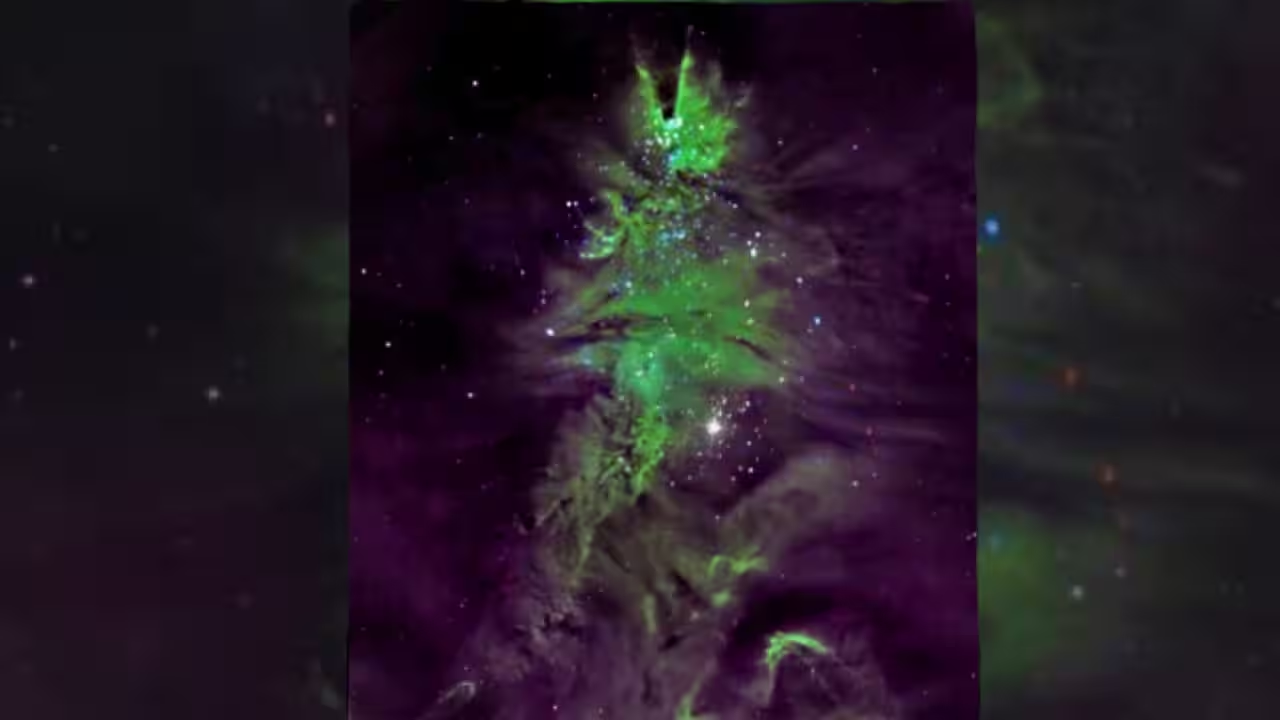Among these captivating displays is the “Christmas Tree Cluster,” officially known as NGC 2264, whose vibrant hues and whimsical shapes remind us of the universe’s artistic brilliance. Accompanying this display is another stunning image, the “cosmic wreath,” showcasing the life cycle of stars through breathtaking visuals.
This holiday season, NASA has brought cosmic wonder to life by unveiling stunning images of celestial formations resembling festive symbols, offering a glimpse into the intricate beauty of the universe.
The Christmas Tree Cluster: A Cosmic Holiday Treat
The Christmas Tree Cluster, or NGC 2264, is a young group of stars located about 2,500 light-years away in the constellation Monoceros. The cluster’s age, between one and five million years, is a mere blink compared to our Sun’s 5 billion years.
These youthful stars are surrounded by green-tinged, cone-shaped clouds, creating the appearance of an evergreen tree adorned with festive charm.
This year, a new image of the cluster has captured the imagination of stargazers. Astro-photographer Michael Clow contributed optical data using a telescope in Arizona, focusing on green and violet light.
NASA’s Chandra X-ray Observatory added red, blue, and white hues to complete the masterpiece. The result is a vibrant, multidimensional portrayal of the cluster, blending science with artistry.
Read : NASA’s Moon Trees from Artemis I Mission Blossom Across the US
Interestingly, the green clouds have sparked comparisons to the Grinch, the mischievous Christmas character, thanks to their uncanny resemblance. This phenomenon, known as pareidolia, allows viewers to see familiar shapes in random patterns, turning the celestial formation into a festive treat for the imagination.
It's beginning to look a lot like cosmos. 🎶
— NASA (@NASA) December 19, 2023
Our @ChandraXray Observatory recently spotted the blue-and-white lights that decorate the "Christmas Tree Cluster," a swarm of stars and gas some 2,500 light-years from Earth: https://t.co/VT2WaLgp77 pic.twitter.com/HrnrmxRyd7
Beyond its aesthetic appeal, the Christmas Tree Cluster offers valuable insights into the life cycle of stars. Astronomers study its structure and composition to understand how stars form and evolve in stellar nurseries. For holiday enthusiasts and scientists alike, this cluster is a striking reminder of the universe’s ability to inspire awe and curiosity.
The Cosmic Wreath: A Celebration of Stellar Life
Adding to the festive celestial theme is the star cluster NGC 602, located about 200,000 light-years away on the outskirts of the Small Magellanic Cloud, one of the Milky Way’s closest neighbors. Dubbed the “cosmic wreath,” this formation showcases the dynamic interplay of young, massive stars and the surrounding interstellar medium.
A composite image released on December 17, 2024, combines data from NASA’s Chandra X-ray Observatory and the James Webb Space Telescope.
The Webb data outline the wreath’s structure, while Chandra’s X-ray observations reveal the young stars at its center. These massive stars emit high-energy light, illuminating the wreath and showcasing stellar activity in one of the Milky Way’s nearest galactic neighbors.

The NGC 602 cluster is a treasure trove of information for astronomers. The high-energy emissions from its central stars offer a glimpse into the intense processes shaping young stellar environments. The wreath-like appearance, highlighted by red hues from Chandra’s data, evokes a sense of cosmic celebration, aligning perfectly with the holiday spirit.
This festive depiction is not only visually stunning but also scientifically significant. It underscores the role of massive stars in enriching the interstellar medium, setting the stage for future star formation. For humanity, it serves as a poetic reminder of our place in the vast, interconnected universe.
The Universe’s Festive Creativity
The stunning images of the Christmas Tree Cluster and the cosmic wreath highlight the universe’s ability to surprise and delight. Beyond their festive appearances, these formations showcase the intricate processes governing stellar evolution, from the birth of stars in nurseries like NGC 2264 to the high-energy emissions illuminating NGC 602.

For astronomers, these images provide valuable data, advancing our understanding of star formation and the dynamics of young star clusters. For the broader public, they offer a moment of wonder, bridging the gap between science and art. The whimsical shapes and vibrant colors remind us that the universe, in all its complexity, holds the power to inspire and uplift.
As we marvel at these cosmic creations, we are reminded of the boundless beauty of the cosmos. Whether it’s the Grinch-like charm of the Christmas Tree Cluster or the glowing elegance of the cosmic wreath, these celestial displays invite us to pause, reflect, and celebrate the mysteries of the universe.

